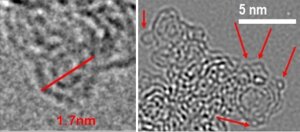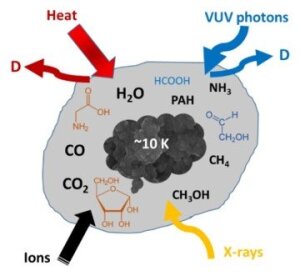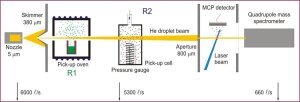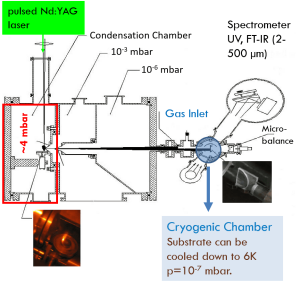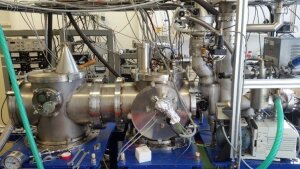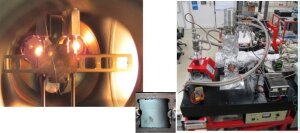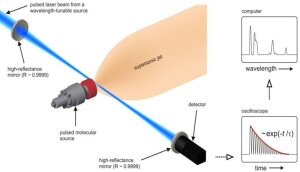Research Interests
High-resolution transmission electron microscopy image of fullerene-like carbon particles.
Image: Cornelia JägerCosmic dust
Nanometer- and micrometer-sized refractory dust grains are extremely important in the evolution of stars and interstellar matter. Their optical properties dictate the interaction with photons and therefore the temperature of dusty regions. Formation processes and radiation-induced processing of grains influence their internal structures, sizes, and shapes, and therefore, their spectral properties. Condensation processes of cosmic dust grains occur in various places including high-temperature condensation in the circumstellar shells around old stars or condensation at cryogenic temperatures and very low densities (10 K, p~10-12 mbar) in the interstellar medium. In the laboratory, formation processes are simulated.
A model of an ice coated dust grain in molecular clouds or protoplanetary disks. Major components of the ice are water, CO, CO2, NH3, CH3OH, and CH4. Temperature– or photon-induced reactions between these species can produce complex organics and even pre-biotic molecules such as glycine or small carbohaydrates. Desorption processes (D) are also possible.
Image: Cornelia JägerInterstellar Astrochemistry
A new experiment was designed for studying astrochemical reactions between ice and dust and between molecular components in the ice layers covering cosmic grains such as carbon and silicates. In the new instrument, we can simulate the physical and chemical conditions prevailing in interstellar environments and protoplanetary disks. The setup consists of an UHV chamber equipped with a closed-cycle cryostat, which can cool down our ice/dust grains to temperatures of about 10 K, and a gas inlet system to produce ice mixtures of various compositions. VUV photons are used to trigger reactions between the molecular components. Chemical reactions are monitored by in situ IR spectroscopy and temperature-programmed desorption in combination with mass spectrometry. In the setup, we simulate chemical reactions that lead to the formation of complex organic and prebiotic molecules in the interstellar medium and in protoplanetary disks. The grain surfaces can have a strong impact on reaction rates and they are able to catalytically influence the surface reactions in ices.
6. The image shows the schematic structure of the He cluster device.
Graphic: Serge KrasnokutskiReactions in helium clusters
Superfluid He droplets (T = 0.37 K) provide an ideal environment to study reactions between embedded molecules and atoms under equilibrium conditions. Helium clusters can be produced by supersonic expansion of pure helium gas at a pressure of 20 bar through a 5μm diameter pinhole nozzle cooled by liquid helium. The liquid He is able to absorb the energy of associative reactions allowing the modeling of reactions on the surface of dust particles. In addition, the liquid He droplet is an ideal nanocalorimeter, which is capable of detecting even small amounts of heat. In case of a chemical reaction, the energy released during this reaction is transferred to the He droplet causing the evaporation of He atoms.
Laboratory equipment
-
Ultra-high vacuum chamber
UHV setup to mimic astrophysical reactions
Image: Cornelia JägerWe developed an ultra-high vacuum (UHV) chamber equipped with a closed-cycle cryostat, which can cool down ice or ice/dust mixtures to temperatures of less than 10 K. Energetic photons or reactive atoms can trigger reactions between molecular components in the ice or between the ice and the dust surface. Chemical reactions are monitored by in situ IR spectroscopy and temperature-programmed desorption in combination with mass spectrometry.
- Closed-cycle He cryocooler (ARS DE-204SB)
- Gas inlet system for the deposition of molecular ices
- Quadrupole mass spectrometer (Hositrad)
- Sources for VUV photons (hydrogen-discharge and a deuterium lamp)
- FTIR spectrometer (Bruker, Vertex 80v) equipped with an external MCT detectetor
-
Laser ablation and solid-particle beam apparatus
Gas-phase condensation setup to mimic the condensation of cosmic dust at high temperatures.
Image: Cornelia JägerThe gas-phase condensation setup is used to condense dust particles of different compositions such as silicates, oxides, carbonaceous grains, carbides and so on that can be used as analogues of cosmic dust. Laser evaporation of a solid target is performed in the presence of various quenching gases. The condensed grains are adiabatically extracted through a nozzle and a skimmer and deposited on a substrate in the fourth chamber, which can be heated or cooled down up to 6 K. A co-deposition with interstellar molecules on the cold substrate allows us to produce dust/ice mixtures at different temperatures. In situ FTIR and UV/vis spectroscopy provide spectral data in a very broad wavelength range. In addition, the dust can be processed by exposure to VUV photons or by heating.
- Nd:YAG laser (532 nm; Continuum Surelite)
- Closed-cycle He cryostat
- FTIR spectrometer (Bruker, Vertex 80v) and an external DLaTGS detector and a broadband detector
-
He droplet experiment
Photo of the He cluster setup used to study surface reactions between molecular components and reaction energies.
Image: Cornelia Jäger- Differentially pumped 5-stage He cluster/ droplet beam apparatus
- Liquid helium-cooled supersonic jet source
- Quadrupole mass spectrometer
- Nd:YAG laser (1064 nm, 532 nm, 355 nm; Continuum NY81-20) + dye laser (Lambda Physik Scanmate 1) for the evaporation of dopant atoms or molecules
- Atomic carbon source (homemade)
- Atomic hydrogen source (HABS; MBE-Komponenten)
-
CVD chamber
UHV setup constructed for the deposition of diamonds at high- and low-temperatures.
Image: Cornelia JägerUHV setup designed for the deposition of diamonds at high- and low-temperature. The vacuum chamber is topped with a cryocooler (photo right side). Left: The back side of the substrate holder containing a glassy carbon that can be heated or cooled in front of the two active C and H atom sources. A glassy carbon substrate with a circular deposit of carbon. The left corner was treated with diamond polish. The device allows us to study the condensation of C atoms on surfaces from cryogenic temperatures (about 10 K) to high temperatures (1400 K). The effect of VUV irradiation on the processes can also be studied.
- Quadrupole mass spectrometer
- Closed-cycle He cryocooler (APD Cryogenics DE-204SLA)
- Atomic carbon source (homemade)
- Atomic hydrogen source (HABS; MBE-Komponenten)
-
Matrix-isolation spectrometer
This setup allows us to measure the UV/vis and IR spectrum of molecules isolated in Ne or Ar matrices. Species in the solid state are brought into the gas phase by thermal evaporation in an oven or by laser vaporization. Isolated species can be ionised by using a H2 discharge lamp.
- Closed-cycle He cryocooler ARS DE-204SL for sample cooling (6.5 K)
- UV-VIS-NIR with optical fibers (Jasco V-670 EX) and FTIR spectrometer
- Nd:YAG laser (1064 nm, 532 nm, 355 nm, 266 nm; Continuum Minilite II) for laser vaporization
- Thermal evaporation source
-
Supersonic-jet laser spectrometer
Sketch of the CRDS jet experiment.
Image: Gaël Rouillé- Vacuum chamber housing a heated pulsed valve or a laser-ablation source
- Nd:YAG laser (1064 nm, 532 nm, 355 nm; Continuum Surelite II-20) + dye laser (Continuum ND6000) + SHG stage (Continuum UVT-1) for spectroscopy
- Photomultiplier (Hamamatsu H6780-04) as CRDS optical detector
- Photomultiplier (THORN EMI 9813QB) as LIF detector
- Monochromator (Jobin Yvon HR-320) and CCD camera (Andor iDus DV420A-BU2) as dispersed emission detector
- Digital oscilloscope (Tektronix TDS3052)
- Nd:YAG lasers (1064 nm, 532 nm, 355 nm, 266 nm; Continuum Minilite I) for laser vaporization
-
Synthesis of carbon particles and molecules
Laser pysorolysis setup for the gas-phase condensation of carbonaceous grains and molecules.
Image: Cornelia JägerA flow reactor designed for the gas-phase condensation of carbonaceous molecules such as polycyclic aromatic hydrocarbons (PAHs) and carbonaceous grains. Different temperature regimes in the condensation zone could be realised either by a cw CO2 laser (λ=10.6 µm; power: 100 W) or a pulsed CO2 laser to achieve tempetarures of ≤ 1700 or ≥ 3500 K, respectively.
Analytical characterisation and fractionation of PAHs were performed by high-performance liquide chromatograph (Jasco) equipped with a diode array detector (MD-2010). The device allowed us to fractionate individual components or mixtures of PAHs.
-
Atomic force microscope (AFM)
Multimode AFM (Veeco) with controller (Digital Instruments Nanoscope III)
Stereo microscope (Carl Zeiss Stemi 2000-C) with CCD camera (Spindler & Hoyer 230 C) and monitor
-
Other Facilities
At the Institute of Solid-State Physics, the group has access to different ion implanters and Rutherford Backscattering Spectroscopy. The group has also admission to high-resolution transmission electron microscopes (HRTEM) equipped with EDX and Electron Energy Loss spectroscopy at the Otto Schott Institute of Material Science.
Recent Projects
- Search for carriers of the diffuse interstellar bands (DFG Project, Dr. Sergiy Krasnokutskiy)
- Temperature-dependent photostability and optical properties of realistic cometary ice composites (DFG Project, PD Dr. Cornelia Jäger) This project is a part of the Research Unit FOR 2285 “Debris Disks in Planetary Systems”, which was established in 2015 to investigate debris disks - belts of comets, asteroids, and their dust around main-sequence stars. Spokesperson is Prof. Alexander Krivov (AIU, Friedrich-Schiller-University Jena) and deputy spokesperson is Prof. Sebastian Wolf (ITAP, Christian-Albrechts-University Kiel). https://www.astro.uni-jena.de/FOR2285/en/External link
- Experimental study of the formation and destruction of carbonates in circumstell and interstellar environments and their impact on the oxygen depletion in the interstellar medium (DFG Project, PD Dr. Cornelia Jäger)
- Energetic photon irradiation of carbonaceous icy grains – Laboratory studied on the innterstellar ice-dust interface in star-forming regions (DFG Project, PD Dr. Cornelia Jäger)
